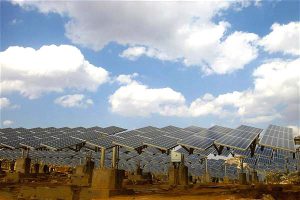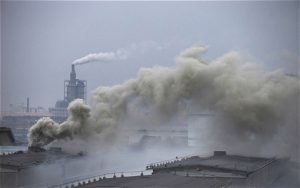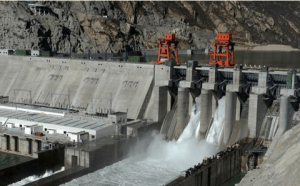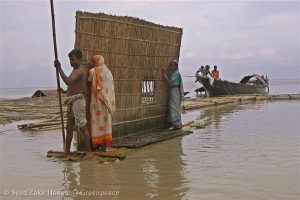Zou Ji, China’s National Center for Climate Change Strategy
China is a big country, but still a poor one.
Yes, it has its mega-rich – Jack Ma, Wang Shi, Wang Jianlin – but average income is low and there are huge income inequalities. Over 100 million Chinese live in extreme poverty, housed in low-quality concrete. They don’t know if their children will finish high school, and have no pensions, much less holidays in the Maldives. If 30-40% of a country’s households live like this, can it be rich?
Defining modern China is complicated. Many residents of first-tier cities enjoy living standards close to developed nations: one family may have several cars and two homes. But elsewhere in the country this is rare.
How should we measure the strength of an economy? One way is to look separately at government and national strength. China’s government is powerful, with an income in the trillions. But it bears a heavier burden than any other government: its income is still too low to provide welfare for all rural residents, it still has 120 million people living under the poverty line. The UN ranks China’s per-capita income in 90th place globally, and we fare even worse in the United Nations Development Programme’s human development index. Is this a rich country?
Developed countries are bound to be rich. But rich countries may not be developed. Saudi Arabia has per-capita income of over US$20,000, but it still counts as developing because of its dependence on oil sales. Eighty percent of government income comes from oil, and if the oil price crashed, the country would be destitute.
Total national wealth does not mean the people are rich. China’s per-capita income is US$7,000, and there are many challenges on the way to raising that to US$10,000. With an economy divided between modern manufacturing and backward agriculture, and vast rural areas, China faces a unique middle-income trap. The country may be no Chad – but nor is it the US. China needs to restructure its economy in order to escape that trap.
Matt Ferchen, Carnegie-Tsinghua Center for Global Policy
The answer to whether China is still a poor country is a complicated mix of both yes and no. In terms of overall national wealth, or GDP, China now ranks either number two or number one, next to the United States. But in terms of GDP per capita, China still ranks only around number 90, reflecting China’s huge population and how far removed the average Chinese citizen’s lifestyle is from those in wealthier countries in North America and Western Europe.
Even within China itself, the answer to this question is complicated by the vast differences between those who live in the wealthier cities near the eastern coast and those who live in less affluent inland or rural parts of the country. Add to this the differences in income and lifestyle between those with the opportunity to get into the best universities, to get the best jobs in government or in business and those without such opportunities and the range of who in China is poor and who is middle class and who is rich only expands.
One area where there is less debate about whether or not China is “poor” is in China’s identity on the world stage. In its foreign relations, China’s leaders have unequivocally chosen to represent China as a “developing county”. Being a developing country may not be exactly the same as being a poor country, but it certainly signals that China is a country that is not as wealthy or powerful as it would like to be.
China’s official foreign policy framework is laid out most clearly in the 2011 State Council white paper called “China’s Peaceful Development”, the title of which emphasises China’s status as a developing country and its overriding concern to continue to pursue its development aims in a way that help build and sustain a peaceful global environment. Granted, China’s developmental gains since the beginning of the Reform and Opening period in the 1980s mean that the country is vastly wealthier at home and more influential abroad than it was back then and the country’s leaders seek commensurate respect for China as a “great power” or 大国.
Even though it is clear that China’s leaders and certainly most of its people clearly identify China as a developing country, greater wealth and influence are common aspirations for the vast majority of Chinese. Not only is China’s developing country identity a source of contradiction at home, but abroad it also can create confusion. In developed countries such as the United States, many see China’s headline growth and GDP figures and see an increasingly wealthy and powerful competitor, not the poorer and weaker China of much of the past two centuries. And even in other regions such as Africa, Latin America or even Southeast Asia where there is a certain sense of admiration for China’s developmental achievements, leaders and people there see China as an increasingly rich and powerful nation.
Di Dongsheng, Renmin University Center for China Foreign Strategy Studies
Exchange rates are key to international comparisons of income or wealth. And those exchange rates are determined by a nation’s development strategy and policy priorities. To take one extreme example: if the exchange rate for the yuan against the dollar suddenly changed from around six to three, China’s per-capita GDP would rise to almost the level of the moderately developed nations.
If we keep the exchange rate high then nominal wealth is greatly increased. But such a sudden change would have a big social impact: an increase in defaults on bank loans and plummeting asset prices, for instance. The priorities for China’s new leadership, and this is particularly shown by Xi Jinping’s own policy stance, place structural adjustments and industrial upgrades before economic growth. This cannot be rushed and these changes will take some time.
China’s climate and environmental policies are not actually determined by income, but by its approach to economic and social development and distribution of the burden of emissions cuts in international negotiations.
The country’s thinking on development has already seen huge changes. In his report to the Third Plenum of the 18th Party Congress last year, president Xi put forward seven major reforms, for the first time in 30 years shifting the focus away from economic construction. Of these, building an ecological civilisation was given equal status with political, economic and cultural reforms. Everything said about the relationship between the environment and the economy, about the natural world, about the changes to the weight given to GDP in evaluation of the performance of officials, about the use of environmental-protection powers, and about the forced closure of blast furnaces in Hebei: it all shows that the idea of a “beautiful China” is not just an empty promise.
However, the issue of what emissions limits to set during international climate talks, and how to set them, risks cementing the divide between rich and poor countries, and trampling on the right to development of the six billion people who do not live in the US, Europe or Japan. This is why China has always stressed the principle of common but differentiated responsibilities (the idea that rich countries should assume a greater share of the costs of tackling climate change).
In the first decade of the 21st century, climate issues became a kind of religion in Europe – while working there I was struck by that. There’s a lot of scientific and political debate over climate change, and I’m no climate expert. But in my view, it’s as if the Europeans have got fat and are now insisting that their hungry neighbours join them in a diet. China’s also putting on a little weight, and so its interests and its stance will gradually change. What interests me is whether the major European powers, after the shock of the debt crisis and growth of regional political challenges, will be so enthusiastic about promoting a global emissions-reduction agenda.
Arthur Kroeber, Gavekal Dragonomics and China Economic Quarterly
The question “is China still a poor country?” can be answered quite straightforwardly. It is not. By the most useful standardised measure of national income, the World Bank’s Gross National Income (GNI) estimates—which include the more familiar gross domestic product or GDP plus net income from abroad—China now enjoys a per-capita GNI of US$6,560. This puts it 86th among the 186 countries for whom recent income data is available.
The World Bank classifies China as an “upper middle income country”. Within this group, China’s per-capita income is a bit below the average figure of US$7,600, but if as seems probable it can sustain a growth rate of 6-7% for the next several years it will become an above-average upper middle income country.
A variety of other data support the intuition that China is now a country of great financial resources. It is the world’s biggest exporter and second-largest importer, behind the United States. It commands nearly US$4 trillion in foreign-exchange reserves, by far the world’s biggest stash. Its direct investments in other countries now average around US$80 billion a year, putting it third behind the United States and Japan. Between 2000 and 2012 China spent more on development assistance in Africa (including official loans) than did the United States.
Yet to say “China is not poor” is not the same as saying “China is rich”. China is obviously not poor, but just as obviously it is very far from being rich. To qualify as a high-income country under the World Bank definition, China would have to double its per capita GNI. Other countries with about the same per capita income as China are Iraq, Peru and Namibia; no one would claim with a straight face that these are rich nations.
China has a surprsingly large population of poor people: about 250 million people, or 18% of the national population, still live on less than US$2 a day. Only India has a larger number of absolute poor. About a third of the urban population of 700 million live in housing without a kitchen or toilet. Because of its enormous size, China has great financial resources. But in the coming two decades the vast majority of these resources must be spent on bringing up its citizens’ access to housing, education, healthcare and other social services to levels that would be considered barely acceptable in rich countries.






